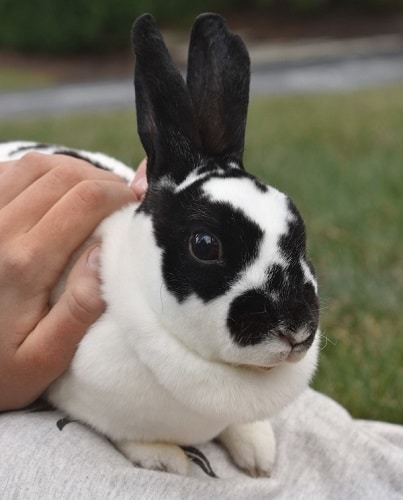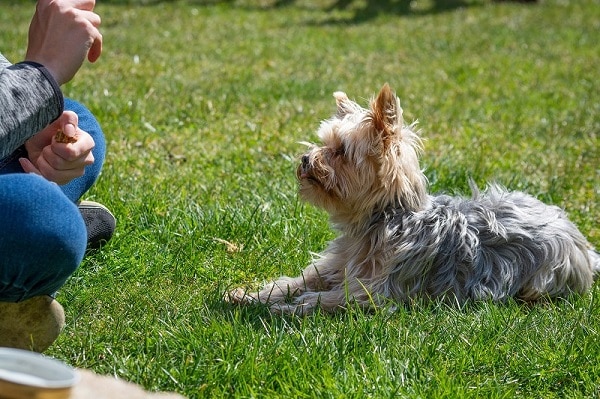



This post is part of a continuing series on preparing your pet for therapy animal work.
If you’re interested in becoming a therapy animal team with your pet, you’ll want to take time to get your animal ready for doing this work. The most important aspect of a successful therapy animal is their temperament; but they’ll also need some preparation for the kinds of experiences they’ll have during therapy animal visits. This preparation will help them be comfortable and happy as therapy animals.
We’ve put together a few preparation suggestions for aspiring teams. These are grounded in our philosophy of YAYABA™, or You Are Your Animal’s Best Advocate. Many of these suggestions are directed at dogs (and especially puppies), since dogs make up more than 92% of our therapy animal team registrations. But the overall concepts can be applied to our other therapy animal species, as appropriate to the species and behavior. These suggestions will be beneficial for any prospective therapy animal, and for you as a handler.

Prospective therapy animals need a variety of experiences, from car rides to visiting with all kinds of people to going to as many settings as possible. Taking the opportunity to expose them to these experiences will be important for future therapy animal work, since therapy animals need to travel to the site of visits and will meet a huge variety of people as part of the work. The earlier you can start this socialization, the better. This might include activities like taking your dog to a public park, to a garden center, and to the pet store. Allow your pet to meet people of different ages, abilities, and ethnicities, as well as individuals wearing uniforms, hats, masks, and glasses.
Each new experience you share with your pet should be pleasant and positive. As you are exposing your pet to new people and places, expect the unexpected and be prepared to deal positively with unanticipated events, because one negative experience can have a lifelong impact for an animal. Don’t overdo socialization experiences; be sure to stop while you and your pet are still having a good time. It’s better to have short, but frequent, positive experiences.

Therapy animals need to be at ease with physical contact. Start by touching their body everywhere including feet, ears, tail, and mouth. Begin with soft and gentle touch and work up to slightly clumsy, but never painful, touch. It’s especially important to start early with young animals, but older animals can benefit from this kind of exposure as well. Take your time and allow your pet to become comfortable with one thing before you move to the next stage. This is important for getting your animal used to physical contact, but it can also help you learn what kinds of touch your pet enjoys most and what they don’t enjoy as much—this will be important to you as a handler in advocating for your pet during therapy animal visits.

Also take time to establish comfort with grooming. Therapy animals need to be groomed before making visits, so ensuring they’re comfortable with it is part of preparing them for this work. Regularly brush your animal’s hair and teeth (where applicable), and touch, clip, or file their nails. Decide if you will be the person to give your pet a bath or if you will have a professional groomer do these tasks. If you plan to use a groomer, be sure to introduce your animal to the groomer and equipment as early as reasonable, so that they learn to consider grooming a routine and pleasant activity.

Find the things that make you and your pet joyful. Like any friendship, you need to experience different things together so that you discover what it is that makes both of you happy. Explore a variety of activities that your pet might enjoy that involve play, enrichment, and connection with you. This could include walks, supervised outdoor time, various kinds of toys, and puzzles or games, depending on your pet’s species. These experiences will also be helpful when you start looking at your pet’s aptitude and interest in visiting, as well as knowing what will help them (and you) decompress after visits.

For experiences that are less desirable for your animal, take steps to improve the situation or shorten its duration. When you’re a therapy animal team, your animal will count on you to advocate for them while visiting. By taking that role seriously for your pet, they will come to trust that you consistently make decisions in their best interest. This trust is the cornerstone for the teamwork needed for every successful therapy animal team.
Basic obedience is necessary for any therapy animal. The specifics will vary depending on the animal’s species. All therapy animals need to be comfortable wearing a collar or harness and leash, following cues from their handler, staying in place for a short period of time, and leaving enticing items when directed. There are some skills that will be specific to each species. For example, dogs need to reliably do sit, stay, down, come when called, and leave it. Other species will have different forms of staying and responding to cues that are based in that species’ behavior.
Pet Partners does not offer or require any specific training course or method. Individual handlers are in the best position to know what training their animals need and what will work best for them to gain the skills to be successful therapy animals. No matter the species, Pet Partners advocates for positive reinforcement and force-free methods for training, because these contribute to the trusting relationship you are building with your pet.

Dog handlers may choose to train their pets individually or with a trainer. If you plan to use a trainer, how do you know which trainer to pick for your pup? Will the trainer be a good fit for you and your pup? You need to consider the methodology that the training center and trainer uses when you select a program. The Association for Professional Dog Trainers has a great resource that can help you answer these questions and choose the right trainer for your dog.
Don’t neglect your own training, either. Learning to read your animal’s body language is critical for a therapy animal handler. Can you identify the subtle cues your animal gives you when they are unsure of a situation? And if so, do you know how to respond to support your animal? Take time to learn your pet’s body language and stress signals, and how you can best support them. For dog handlers, the Pet Partners online Canine Body Language Course is a great place to start.

The selection of a veterinarian is critical to your pet’s long-term well-being. A successful relationship with your veterinarian is built on mutual trust, respect, and communication. Look for someone with a similar approach to pet care as you, who will be open to questions and who values your observations about your animal. Your pet’s veterinarian will need to confirm that your pet is healthy enough to register as a therapy animal. A good relationship will help your veterinarian stay connected to your pet’s health and allow them to make that affirmation confidently.
There isn’t a formula for determining if any particular animal is going to be a good therapy animal. Successful therapy animals are affiliative in nature. They enjoy spending time with people, and not just their handler or family, but people they haven’t met previously. Their strong bond with their handler translates into a trust that you will keep them safe, so they can be more tolerant or forgiving of clumsy interactions or surprising distractions. They enjoy providing comfort to others and seek out interactions.

Your pet’s own individual personality and preferences will help you determine their aptitude for visiting and the type of visiting they might enjoy. A young, energetic dog might like visiting with multiple people at a time. A cat who likes to interact with people one on one may prefer visits where they can be in an individual’s room with quiet focus. A bird who enjoys the sound of people talking might like to do Read With Me visits.
Ultimately, it is your responsibility as your animal’s best advocate to ensure that your animal truly enjoys—not merely tolerates—therapy animal interactions. As an example, a dog with strong obedience skills may be able to perform some therapy animal tasks, but if they are enduring the interactions because they feel they must follow your direction rather than because they enjoy doing it, that could ultimately erode the trusting relationship with your animal. It is up to every pet owner to be their animal’s advocate and make choices in their animal’s best interests, including whether therapy work is the right choice.

Pet Partners provides a comprehensive registration process that evaluates a prospective therapy animal team (handler and animal working together) for volunteer work. The registration involves a combination of coursework and assessment, and provides information and resources to help you know what to expect and the skills you and your pet will need. Learn more about becoming a handler and create an account in the Volunteer Center to get started.
Ready to learn more about preparing your pet to become a therapy animal? Read the other posts in our series: